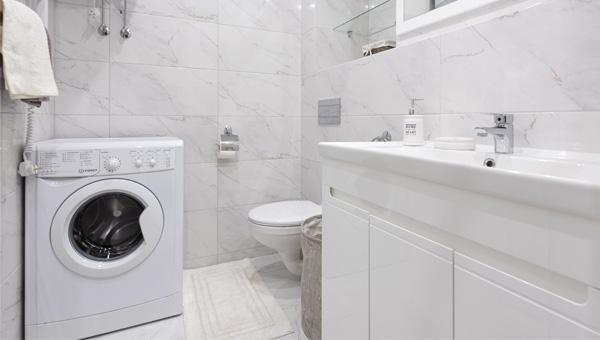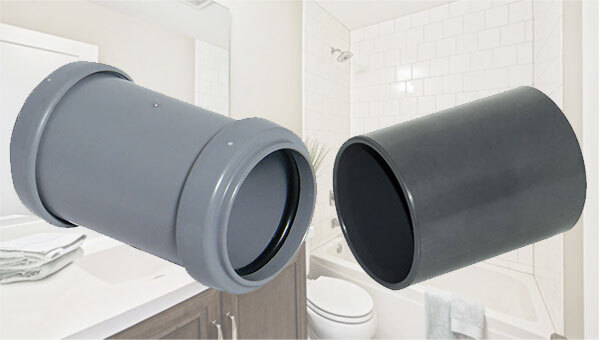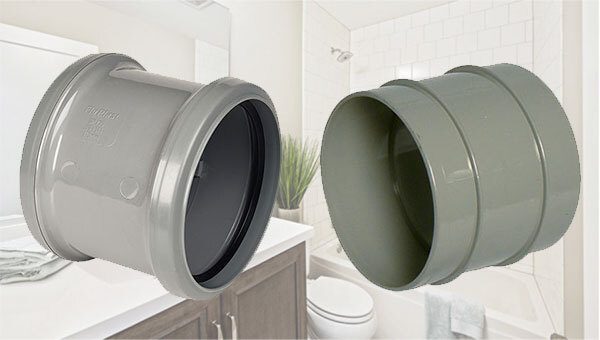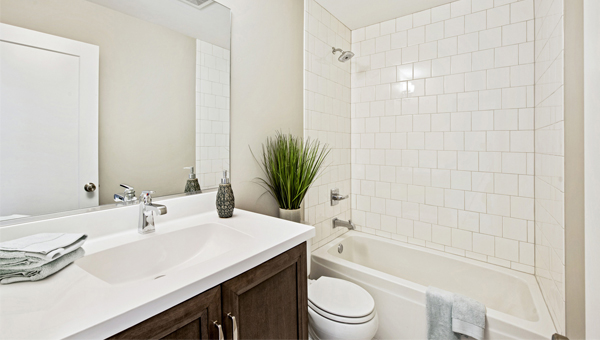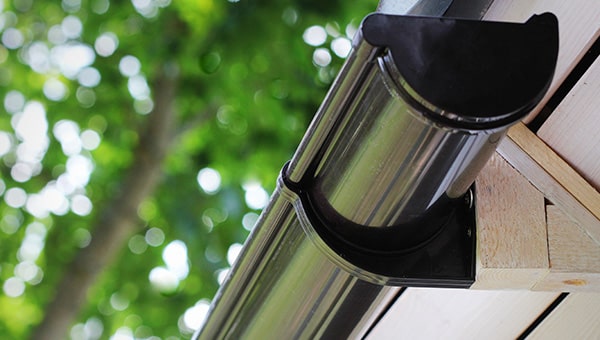
The topic of rainwater guttering can be a confusing one, despite the systems themselves being fairly simple, and it can be difficult to find the answers you need all in one place. For that reason, we've put together this handy FAQ article to hopefully answer all your guttering and downpipe related questions.
What are the main types of gutters?
There are three general types of guttering commonly used: parapet gutters, valley gutters and eaves gutters — the most popular type.
- Parapet gutters - drainage channels for flat roofs with parapet walls. Channels water through a gap in the wall and into a downpipe.
- Valley gutters - lengths of metal flashing installed along any junction where two roofs meet, or where there is a change in direction of the roof.
- Eaves gutters - that run along the edge of your roof and channel rainwater into a downpipe where it is deposited into a drain.
Eaves gutters are the most recognisable type, and the type most of us are interested in when it comes to DIY projects. For information about the different types of eaves guttering, see the question below. If you have a project involving parapet or valley gutters, we would recommend calling in professional roofers to help.
What type of eaves gutters are available?
Gutters come in a variety of materials and profiles to suit different tastes and needs of the property. The most common gutter profiles (shapes) are half round, deep gutters, box or square gutters, and ogee (or K-style) gutters.
- Half-round gutters- the traditional half-pipe style, common on older properties. Your bog standard, basic gutter that’s ideal for most standard properties at a budget-friendly price.
- Deep gutters - like the half-round, but deeper. Able to cope better with high capacity water flow. Ideal for steep roofs and properties in areas prone to heavy rainfall.
- Box/Square gutters - an angular upgrade to the half-round with a deeper channel. Easier to install, due to the flat surfaces on all sides, and Ideal for contemporary properties.
- Ogee/K-style gutters - flat backed, for ease of installation, with a decoratively shaped front that can help elevate the look and finish of your property. The deeper channel caused by the shape makes them ideal for roofs with high capacity water flow.
Each of these styles are available in either PVC plastic or a range of different metals, including cast-iron, steel and copper. For more information about these material types, as well as the profiles listed above, check out our guide to the different types of guttering.
What types of downpipes are there?
Downpipes (also known as downspouts) are available in all the same material choices as gutters are (either plastic or a variety of metals), but only two styles: round or circular and square downpipes.
- Round/Circular - usually best suited for use with Half-round and Deep gutters.
- Square - usually best suited for use with Box and Ogee gutters.
Connection pieces for converting square outlets to round, and visa-versa, are readily available though, meaning you can mix and match if you choose.
Which type of eaves guttering are best?
This will depend on a number of factors, including the size and pitch of your roof, what your budget is and what kind of property you have. Check out our basic guide to guttering for a quick pro’s and con’s comparison of the different materials and profiles guttering comes in.
Our personal recommendation is to go with PVC plastic for the material, as it is easy to install/repair and very cost efficient, and then either half-round or square gutters for most standard roofs, and deep or ogee gutters for steep roofs or properties in heavy rainfall areas. We offer an extensive range of Floplast gutters that cover all these options, and there’s even a cast-iron effect range if you want guttering that has that traditional look but don’t want higher costs and maintenance needs associated with that material.
What size are standard gutters?
Sizes vary from brand to brand of guttering, but, for our Floplast range, the standard size starts at 112mm with our half-round gutters. This measurement indicates the width of the gutter at its widest point.
Here’s a quick rundown of the sizes we stock and the compatible downpipes:
- Half-round- 112mm (wide) by 52mm (deep) - connects to 68mm Round Downpipe - available in "Cast-Iron" effect.
- Square Line - 114mm (wide) by 60mm (deep) - connects to 65mm Square Downpipe
- Hi-Cap (Deep)- 115mm (wide) by 75mm (deep) - connects to either 68mm or 80mm Round Downpipes - available in "Cast-Iron" effect.
- Niagara Ogee - 110mm (wide) by 80mm (deep) - connects to either 65mm Square, 68mm Round, or 80mm Round Downpipes - available in "Cast-Iron" effect.
- MiniFlo - 76mm (wide) by 38mm (deep) - connects to 50mm Round Downpipe.
- XtraFlo - 170mm (wide) by 108mm (deep) - connects to 110mm Round Downpipe.
Additionally, we also have the following MiniFlo range (ideal for garages & sheds) and XtraFlo range (ideal for large commercial buildings).
Are round gutters better than square gutters?
Not particularly, it’s mostly down to personal choice over how they look. Half-round and Deep gutters do have a smoother internal shape, which can make them a bit easier to clean than Square or Ogee gutters. However, when comparing Square to Half-round and Ogee to Deep, the more angular profiles do tend to have a slight edge when it comes to capacity, since they lose less space to rounded edges.
The best way to choose which style is right for your property is by working out the Effective Roof Area of your property and then matching that to the maximum flow rates of each type of gutter. Follow our guide to determining the right gutter size for your house for help with this.
Is plastic guttering as good as metal?
Plastic can be as good as metal guttering. While it’s true that metal guttering systems are generally stronger than plastic systems, and therefore less prone to damage, they are also heavier (making installation more difficult), more expensive and can require more maintenance to keep them weather resistant. Modern PVC plastic gutters are durable, robust, weather resistant, flexible, easy to install, easy to maintain and very cost efficient.
The biggest benefit metal guttering has over plastic, depending on the type of metal, is a longer lifespan. Copper and cast-iron, for example, can last you a lifetime if properly looked after. However, they are very expensive which makes them a long-term investment for your property. You could probably replace a standard plastic system a few times over for the price of a copper system... and it will likely serve you just as well. All the guttering material types have their pros and cons though, and all are better suited to certain properties or environments more than others. Rather than asking which one is better, it is more beneficial to ask which one is better for your property and your project. Check out our article on the different types of guttering for a deeper dive into the options available and what properties they are best suited for.
Guttering Installation FAQs
Commonly asked questions about installing guttering and downpipe.
Can you replace gutters yourself?
Yes you can replace gutters yourself. With a bit of planning and guidance, (see our how to plan and prepare a new guttering installation) replacing your gutters is one of the more straightforward DIY jobs you can undertake. If you choose a new plastic guttering system to replace your old one with, installing it is as easy as following our step-by step gutter installation guide.
The trickiest part can be in removing your existing guttering. Depending on age and material type of your existing gutters, you may need to saw through the fittings to get them down. If you have old cast-iron gutters, for example, they could be rusty, have sharp edges, and will definitely be too heavy to take down safely on your own. Fortunately, our plan and prepare guide has a section on removing your old guttering that can help.
How much does it cost to replace gutters?
For a typical 3-bed semi-detached property in the UK, requiring 15-20m of guttering with 2-3 downpipes, the cost of having a professional replace your old guttering with new PVC guttering is around £500-£700. For metal gutters, the cost will be substantially higher.
The cost of the materials for a job like this will be around £200-£300 though, so you can save a lot of money by doing the job yourself. It is only worth the saving though if you are confident in your DIY abilities and comfortable working at height.
Hiring a professional is always the safer option and (if you use a site like Checkatrade.com to find a reliable, trustworthy tradesperson) gives you the peace of mind in knowing that the job will be done right. Professional quotes will also factor in the removal and disposal of your old guttering for you - something you’ll have to sort out yourself if you go down the DIY route.
How long does it take to replace guttering?
For a typical 3-bed semi-detached property in the UK, requiring 15-20m of guttering with 2-3 downpipes, replacing an old guttering system with a new PVC one will usually take around 5-6 hours. For larger properties, properties with complicated roof shapes, or if you are replacing your old system with metal guttering, it will likely take a lot longer.
Do you need scaffolding to replace guttering?
No, you may not need scaffolding to replace your guttering, as the work can be done with any suitable ladder, but it does make the job a lot easier and safer to do.
However, you may struggle to get a good price on hiring scaffolding for a one day job (which is how long a typical gutter installation will take). The better prices come when hiring them for at least a week, so, if you would like the added safety and ease that scaffolding affords, perhaps consider what other jobs need doing on your property (such as painting the walls, cleaning the windows, installing bird boxes, or finally taking down your Christmas lights/putting them up early) to really get your money’s worth out of the rental cost.
Important Note: All scaffolding projects in the UK require a permit to be obtained to ensure that all safety standards are met. The company you hire the scaffolding from should do this for you, but it is your responsibility to make sure they have and as for proof before the scaffolding can be erected.
Are gutters affected by building regulations?
Yes — building regulations in England, Wales & Scotland require that any installed guttering is fit for the purpose of protecting the foundations of your property, and any neighbouring properties, from rainwater damage. However, as long as you buy quality brands from trusted suppliers, and ensure your installation is done correctly and sized properly for your roof, this shouldn’t be anything you need to worry about.
- For England & Wales, see Building Regulations Approved Document H section H3.
- For Scotland, see Building Standards standard 3.6.
- For Northern Ireland, see Technical Booklet N - Drainage.
Building regulations can also stipulate that rainwater must always be discharged into a surface water drain/soakaway though, and never a foul water drain, unless your property has a combined drains system. If you are in any way unsure about this, check out our article on the right drain connections for your property. There are also regulations surrounding what types of guttering can and can’t be used on listed and heritage buildings, which usually require a like-for-like match to the existing material and appearance.
Gutter maintenance and repair work doesn’t normally, for most properties, require any planning permission, but it’s always worth double checking with your local authority just to be sure.
Should the size and shape of my roof affect my choice of guttering?
Yes you absolutely must make sure that the guttering you choose is able to adequately service the expected capacity and flow rate of the water running off your roof when it rains.
The larger your roof is, the greater the capacity of the gutters will need to be, and the steeper the slope, the faster the flow rate of the water into the gutters will be. If either of these are under calculated, your guttering system will be unfit for the purpose of protecting your property. Always size your roof and fit your choice of guttering around that result.
How do you calculate the size of your roof?
This will depend on the type of roof you have, and there are a few ways you can do it - which we discuss in more depth in our guide to sizing your guttering for your roof. Essentially, you need to find out what the effective roof area of your property is.
Here are the calculations for two common roof types:
- For a gabled roof - Roof Length x (Half Roof Width + Pitch Multiplier) = Effective Roof Area.
- For a hipped roof - Roof Length x Roof Width x Pitch Multiplier = Effective Roof Area.
How do you work out the pitch multiplier for your roof?
If you follow our guide to sizing your guttering for your roof, you won’t need to. Our handy roof pitch multiplier table has the figures already worked out. If you would like to know how to do it all yourself however... put your school cap on and prepare to go back to high school trigonometry!
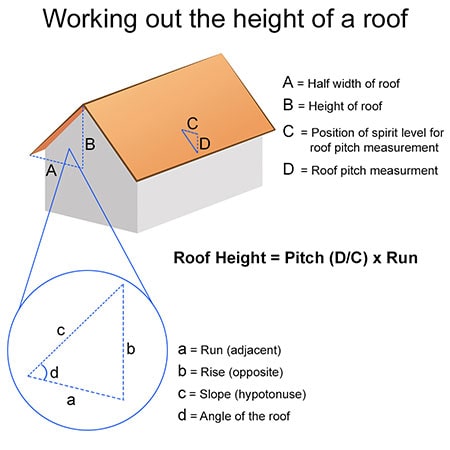
First, we need to turn our roof into a triangle as shown in the image. The calculation for working out the roof pitch multiplier is Hypotenuse (Slope) divided by Adjacent (Rise) - which is to say, the length of the slope of your roof needs to be divided by the height of the rise of your roof. If you already know the values for each side of your triangle, then this calculation should be very straightforward.
If you don’t already know these values, however, we’re going to have to do a bit more work to figure them all out. At the very least, you need to know the run (half width) of your roof and the pitch.
How to work out the Run of your roof
If you have no other figures to work with, the only way to get this measurement is to actually go and physically measure the width of your roof and then divide the value by 2. For this example, we’re going to use a measurement of 8.7 metres, which makes our run 4.35 metres.
How to work out the Pitch of your roof
Place one end of a spirit level (that’s at least 31cm/12inch long) up against the slope of your roof (either from outside on a ladder or inside from your loft) and find the level point. Using a tape measure, take a measurement from the 31cm/12inch mark out from the roof down to where the tape meets the slope at a right angle (or up to the slope if you are in your loft). That measurement will give you the pitch which is noted as being x/31 (or x/12 if you are using inches).
Top Tip: This measurement is a lot easier to take in inches and, as such, that is how we will show it for our calculations. However, it works exactly the same way for either unit of measurement.
So, if our measurement was 9 inches down from the 12 inch mark would be recorded as 9/12. That is our roof Pitch which, along with our Run figure, will allow us to now work out the height (Rise) of the roof.
How to work out the Rise of your roof
The calculation for this is Pitch multiplied by Run, which for our example would be 0.75 (9/12) x 4.35 = 3.26. Therefore, the height of our roof is 3.26 metres. With this figure worked out, we can now calculate the length of our roof Slope.
How to work out the Slope of your roof
This calculation is a bit more tricky and will require the use of a scientific calculator. Fortunately, the functions we need can actually be found on most smartphone or PC calculators:
- On an iPhone, simply open the calculator app and turn the phone on its side.
- On an Andriod phone, open the calculator app and select "Advanced Panel" and then "Scientific".
- On desktop, open the built in calculator. On Windows, this is found in your Start menu under Windows Accessories. On macOS, you can find Calculator.app via Launchpad or Spotlight. Click on the "View" menu option and select "Scientific".
Once you have your calculator sorted, we can use our Run and Rise figures to work out the Slope. On your calculator, type in the Run value and press the "𝒙2" symbol (that should appear in your scientific mode), then press plus "+" followed by the Rise value and the "𝒙2" symbol again. Next, press the equals "=" button followed by the square root "√" symbol (some calculators this may be shown as "2√x") to get your value for the Slope of your roof e.g.
Slope (hypotenuse) = 4.35 𝒙2 (18.9225) + 3.26 𝒙2 (10.6276) = 29.5501 √ = 5.436 metres
Now that we know this value, we can go back and calculate our pitch multiplier.
How to work out the Roof Pitch Multiplier
Using the calculation of Hypotenuse (Slope) divided by Adjacent (Rise), we can get the following value: 5.436/4.35 = 1.25. That makes 1.25 our roof pitch multiplier. Use this figure with the calculation in the previous question to work out the effective roof area of your house.
How do you work out the Angle of your roof?
To work out the angle of your roof, we’re going to need to know the height and the half width of your roof and then use the tan-1 function on a scientific calculator.
On your calculator, type in the value of the Rise, press the divide by button, type in the value of the Run and then press the equals button. Next, press the inverse scientific function button on your calculator (shown as either "Inv", "shift" or "2nd"), followed by the "tan-1" button to get the angle of your roof: e.g.
Roof Angle = 3.26/4.35 = 0.749 Inv, tan-1 = 36.85 degrees
Is there an online calculator that can work out my roof area for me?
Yes, if you really want to avoid all the calculation headaches and just have someone tell you exactly what size guttering you need for your house, our friends over at Floplast have got you covered. They have a helpful calculator for single, hipped, valley and double valley roofs that will take your roof measurements and work out exactly which of their guttering systems you will need (all of which you can buy online from JDP).
All you will need to know is the length, width and pitch (angle) of your roof and the number of outlets (downpipes) you require.
Does my guttering need to be installed with a fall?
Guttering doesn’t Need a fall to work, but it definitely should have one in order to work more efficiently. Installing gutters without even just a gentle slope down towards the downpipe will drastically reduce the maximum flow capacity and effective roof area that your system can cope with.
Installing them with a fall helps gravity do its job of channelling rainwater down into the drains and away from your property, and also reduces the chance of any water being left pooling up in the gutters.
How much fall does guttering need?
A fall ratio of 1:350 is recommended for ensuring a good water flow down to the outlet. This roughly equates to a 3mm (0.1inch) drop for every 1 metre/1000mm (3.3ft) length of your gutter run.
Check out our guttering installation guide for more on gutter fall and flow.
How do you install gutters and downpipes?
By following our guides to planning your gutter installation and installing a new guttering system. In these two articles we walk you through everything you need to know and do to install new gutters and downpipes correctly.
Gutter Maintenance FAQs
Why do you need to clean your gutters?
Because they catch more than just rainwater. Whether it’s leaves falling off trees, clumps of moss rolling off your roof, twigs being dropped by birds, or dirt and other debris getting picked up by the wind and deposited on your roof, there are a lot of different things that can get washed into, or fall into, your gutters...and all of them can eventually cause blockages.
If you leave your gutters for too long without cleaning them then you are almost certainly going to end up with a build-up of this material somewhere in the system that can hinder or stop the flow of rainwater and compromise the integrity of your guttering. Blocked gutters can be the root cause of more serious problems such as leak in your roof, damp in your walls and water damage to your foundations. These are all problems that can be extremely costly to fix, yet they can all be prevented by just cleaning out your gutters on a regular basis.
How often should you clean your gutters?
According to industry experts you should clean out your gutters at least twice a year - preferably around the end of the Spring months and then again in the Autumn. These are the times of the year when nature likes to dump its discarded debris all over your property, which means a lot of it is going to end up in your gutters.
Ideally, however, you should be a bit more proactive in trying to keep your guttering ship-shape and working efficiently. Be mindful of the environment around your property that could cause more frequent build ups (if you live near a field that could kick up dust and bits of dry grass during harvesting times, for example). Also think about the effect strong storms can have on debris getting caught in your gutters. You may have only just cleaned them last week, but if a particularly heavy storm just hit your area, there could be a load of fresh future blockage material up there just waiting to clog up your system. Waiting for just those two recommended times of year to clean your guttering may not always be sufficient to prevent blockages.
How do you know if your gutters need cleaning?
Often there will be obvious signs that your gutters are in need of a good clean, such as water overflowing from them, damp patches on the floor beneath them, or plants growing out of them. Ideally, you don’t want to wait for these signs to appear though. Keeping to a regular maintenance schedule will help prevent the blockages that cause these signs to appear.
Check out our guide to rainwater guttering maintenance for a more detailed look at the signs to look out for and how best to keep your guttering system at its best.
How do you clean gutters?
With a set of ladders, a pair of marigolds and a bucket. Climb the ladders (safely), scoop out the gunk with your gloved hands and put it in the bucket for easy transport to a suitable disposal site (a.k.a. a garden waste bin). That’s the short answer. For more detailed, step-by-step instructions, check out our handy guide to cleaning your gutters.
How do you clean your gutters without a ladder?
If you don’t want to go climbing up ladders but do still want to avoid paying someone else to clean your gutters for you, there are telescoping gutter cleaners, brushes, vacuums and hoses that you can buy that will enable you to do the job from the ground. However, none of these tools allow you to see what is up there in the guttering, meaning that it is quite easy to miss clearing out potential blockage material.
If you don’t feel safe working at height yourself, we would recommend that you first get the job quoted by a professional tradesperson before investing in tools to do the job from the ground. Spending a bit more now to get the job done right can save you money in the future by avoiding blockages that could cause damage to your guttering and your house.
How do you prevent gutters from blocking?
There is no fool-proof way to completely stop debris from getting into your gutters, and potentially building-up into blockages, that wouldn’t also stop the flow of rainwater too. There are, however, certain gutter protection products that you can buy (including gutter guards, brushes, and balloons) that can help prevent the larger types of debris, such as leaves and twigs, from getting through. If combined with a regular maintenance schedule, these products can help keep your gutters cleaner for longer.
Should you repair or replace damaged gutters?
This will depend on the extent of the damage. Small cracks, splits and holes can be repaired with special roof and gutter sealant or weather-proof tape. However, these tend to only be delay tactics to eventually replacing the damaged section. The best option is often to simply replace the parts that are damaged. If you have a PVC plastic guttering system, like the Floplast ones we stock here at JDP, replacing gutter lengths and fittings is incredibly simple, thanks to their snap-fit design, and could even cost you less than buying some of the specialist repair products.
How do you know if your gutters need replacing?
If your existing plastic guttering system is over 10 years old, hasn’t been properly maintained, and has more leaks than the Titanic after hitting the iceberg...it’s probably time to replace it. Large cracks, discolouration and misshapen gutter lengths are all signs that the system is past its prime and probably should be replaced.
For metal guttering, the biggest killer is rust. If caught early enough, it can be repaired, treated and prevented with suitable sealants, primers, and weather-proof paints. If neglected for too long though, rust can eat holes in the guttering and weaken its structural integrity to the point of it becoming unsafe to have on your roof. If most of your metal guttering is covered in rust and large holes are starting to appear in them, it’s definitely time to replace your system.
Check out our article on 10 common gutter problems and how to fix them for advice on what problems can be repaired to then better understand the ones that can’t.
How do you fix leaking gutters?
That depends on where the leak is in the guttering system. Fortunately, we have put together a pretty extensive guide on how to fix a leaking gutter or downpipe to help you find the right solution for the type of leak you have.
And that’s it for this guttering FAQ! Hopefully we have been able to answer all the questions you had, but if you do have any further questions, or need any advice on how to install, operate or maintain a guttering system, contact us today — our team of experts are always on hand to help with all of your drainage needs.


